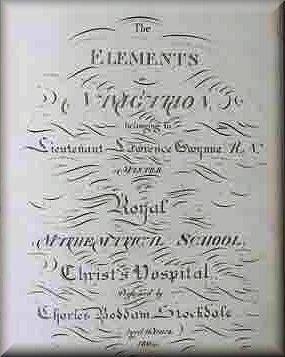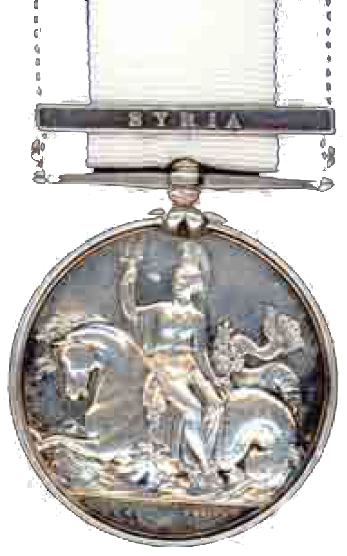‘Schoolies’: Teachers of the Royal Navy and Royal
Marines 1700-1914
It was during the same period when these campaign awards were issued that the seamen’s schoolmaster first saw his rating appear on medals: one was a Long Service & Good Conduct (LS&GC) ‘anchor’ type, the other a wide suspender type (dated 1848). In fact, it was the silver debut of the grammatically dysfunctional ‘seaman’s schoolmaster’, which remained as such for some three decades of this title’s existence (with one exception, which will be dealt with later). The two schoolie ratings entitled to the China Medal 1840-42 cannot be given consideration here, since higher powers determined that only the petty officer rank would appear on this medal, not the rating. The existence of a silver issue St Jean D’Acre Medal 1840, privately engraved to the Rodney’s seamen’s schoolmaster, begs some theorising. As a petty officer 1st class, he should have received a copper award, but one wonders if a silver medal was issued due to an understandable error. Considering that the short-lived title of ‘naval instructor and schoolmaster’– carrying with it full warrant status – was introduced just four years earlier, and the rating of seamen’s schoolmaster followed a mere five months afterwards, confusion once again reigned for schoolies and their medals. Curiously, on the recipient’s part, the final two characters of the naming, R.F.E. MORISON. R.N. (Morrison on roll), hint at a higher rank, so perhaps Morison harboured loftier notions about himself. And with a ring attached to a watch fob and straight silver bar suspension, ribbon buckle and pin brooch, his award certainly takes on the air of an officer’s medal. NGS for Syria to Naval Instructor
Likewise, it is worth noting that at Navarino many years previously, the Talbot carried Acting Schoolmaster John Dellamore. During the same time period, Acting Schoolmaster H.J. Strutt was serving aboard the frigate Boadicea in the First Burma War (Army of India 1799-1826, with clasp ‘AVA’), though his vessel had only 284 on board. In these cases, the complements permitted only ‘acting’ schoolies. The ‘350 Rule’ was in force in respect of the four ships selected to receive officially impressed Crimea Medals 1854-56: London (743 men), Rodney (851), Niger (187) and Wasp (180), the last two not having any seagoing teachers (or chaplains) on board. Rodney carried three chaplains, but as far as can be ascertained, none of these gentlemen qualified as naval instructors. |
 According to
O’Byrne, schoolie Thomas Eastman entered the service as a naval instructor
on 22 December 1836, the very day the title of ‘naval instructor and
schoolmaster’ officially came into existence. Evidently, the old title of
schoolmaster found its way by his name on the Syria roll, so he was deprived of
having his rank impressed on the medal.
According to
O’Byrne, schoolie Thomas Eastman entered the service as a naval instructor
on 22 December 1836, the very day the title of ‘naval instructor and
schoolmaster’ officially came into existence. Evidently, the old title of
schoolmaster found its way by his name on the Syria roll, so he was deprived of
having his rank impressed on the medal. The ‘350 Rule’
The ‘350 Rule’